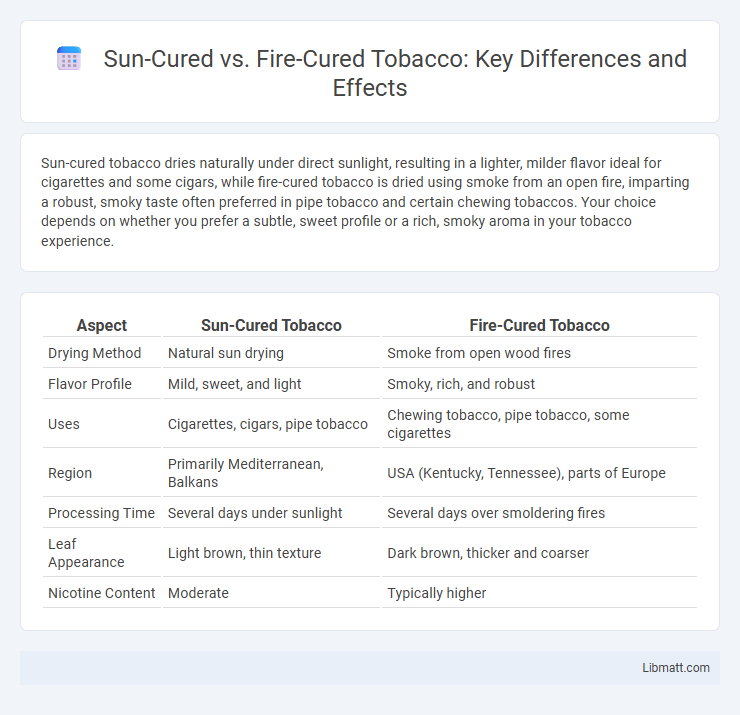Sun-cured tobacco dries naturally under direct sunlight, resulting in a lighter, milder flavor ideal for cigarettes and some cigars, while fire-cured tobacco is dried using smoke from an open fire, imparting a robust, smoky taste often preferred in pipe tobacco and certain chewing tobaccos. Your choice depends on whether you prefer a subtle, sweet profile or a rich, smoky aroma in your tobacco experience.
Table of Comparison
| Aspect | Sun-Cured Tobacco | Fire-Cured Tobacco |
|---|---|---|
| Drying Method | Natural sun drying | Smoke from open wood fires |
| Flavor Profile | Mild, sweet, and light | Smoky, rich, and robust |
| Uses | Cigarettes, cigars, pipe tobacco | Chewing tobacco, pipe tobacco, some cigarettes |
| Region | Primarily Mediterranean, Balkans | USA (Kentucky, Tennessee), parts of Europe |
| Processing Time | Several days under sunlight | Several days over smoldering fires |
| Leaf Appearance | Light brown, thin texture | Dark brown, thicker and coarser |
| Nicotine Content | Moderate | Typically higher |
Introduction to Tobacco Curing Methods
Sun-cured tobacco undergoes a natural drying process using direct sunlight, resulting in leaves with lower moisture content and a milder flavor, commonly used for Oriental tobacco varieties. Fire-cured tobacco is exposed to smoke from wood fires in controlled curing barns, imparting a smoky aroma and richer taste preferred in certain pipe and chewing tobaccos. These curing methods significantly influence the chemical composition, flavor profile, and moisture levels of the final tobacco product.
What is Sun-Cured Tobacco?
Sun-cured tobacco is a type of tobacco leaf dried using natural sunlight, resulting in a low-nicotine and mild-flavored product commonly used in cigars and certain pipe tobaccos. This curing process enhances the sugar content and reduces harshness, producing a smooth and aromatic tobacco profile. Sun-cured tobacco is primarily grown in regions with consistent, intense sunlight, such as parts of Africa and the Mediterranean.
What is Fire-Cured Tobacco?
Fire-cured tobacco undergoes a drying process using smoke from open hardwood fires, imparting a rich, smoky flavor essential for products like pipe tobacco and certain cigars. This method contrasts with sun-cured tobacco, which dries naturally under sunlight, resulting in a lighter, milder taste. Understanding the fire-curing process helps you appreciate the robust, aromatic qualities unique to fire-cured tobacco varieties.
Key Differences Between Sun-Cured and Fire-Cured
Sun-cured tobacco is dried naturally by exposure to the sun, resulting in a milder flavor with lower nicotine content and less ash residue. Fire-cured tobacco undergoes a slow drying process using smoke from open fires, which imparts a robust, smoky flavor and higher nicotine levels. These distinct curing methods significantly influence the tobacco's taste profile, aroma, and chemical composition.
Flavor Profile Comparison
Sun-cured tobacco offers a naturally sweet and mild flavor profile with subtle grassy and hay-like notes, ideal for those who prefer a smoother smoking experience. Fire-cured tobacco delivers a robust, smoky taste infused with rich, earthy undertones due to the exposure to open flames during curing, making it perfect for bold and intense flavors. Your choice between sun-cured and fire-cured will significantly impact the aroma and depth of taste in your tobacco products.
Impact on Tobacco Color and Texture
Sun-cured tobacco develops a lighter, golden to straw-like color with a smooth and flexible texture due to prolonged exposure to natural sunlight promoting slow drying. Fire-cured tobacco, exposed to smoke from open fires during curing, results in a darker, richer brown hue and a denser, tougher texture influenced by smoke absorption and heat intensity. The curing method directly affects the chemical composition, impacting the tobacco's flavor profile alongside its color and texture differences.
Regional Variations in Curing Techniques
Sun-cured tobacco, predominant in Mediterranean and African regions, relies on direct sunlight to dry leaves, imparting a mild, natural sweetness and preserving high sugar content. Fire-cured tobacco, common in the Appalachian Mountains and parts of the American South, utilizes controlled hardwood smoke to dry leaves, resulting in a robust, smoky flavor with increased nicotine and tar levels. These regional curing variations reflect local climate conditions, cultural preferences, and historical tobacco production practices.
Uses in Cigars, Pipes, and Chewing Tobacco
Sun-cured tobacco undergoes natural drying under sunlight, producing a milder and sweeter flavor ideal for cigars and certain pipe tobaccos where smoothness is desired. Fire-cured tobacco, exposed to smoke from open fires during curing, imparts a smoky, robust profile favored in pipe tobacco blends and chewing tobacco for its rich and smoky character. Your choice between sun-cured and fire-cured tobacco significantly influences the flavor and aroma profile suited to cigars, pipes, or chewing tobacco.
Health Implications and Chemical Composition
Sun-cured tobacco undergoes natural drying, resulting in lower levels of volatile compounds like ammonia but higher sugar content, which can influence the nicotine delivery and overall harshness. Fire-cured tobacco involves exposure to smoke from open flames, introducing phenols, cresols, and other harmful polycyclic aromatic hydrocarbons that increase the risk of respiratory and cardiovascular diseases. Understanding these differences helps you make informed choices regarding tobacco use and its potential health impacts based on chemical composition and curing methods.
Choosing the Right Curing Method for Your Needs
Selecting between sun-cured and fire-cured methods depends on the desired flavor profile and environmental conditions. Sun-cured tobacco offers a mild, slightly sweet taste ideal for cigars and pipe tobacco, benefiting from natural sunlight and warm temperatures during curing. Fire-cured tobacco imparts a smoky, robust flavor suitable for certain pipe tobaccos and chewing tobacco, requiring controlled exposure to smoke from hardwood fires to achieve its characteristic aroma.
Sun-cured vs Fire-cured Infographic

 libmatt.com
libmatt.com